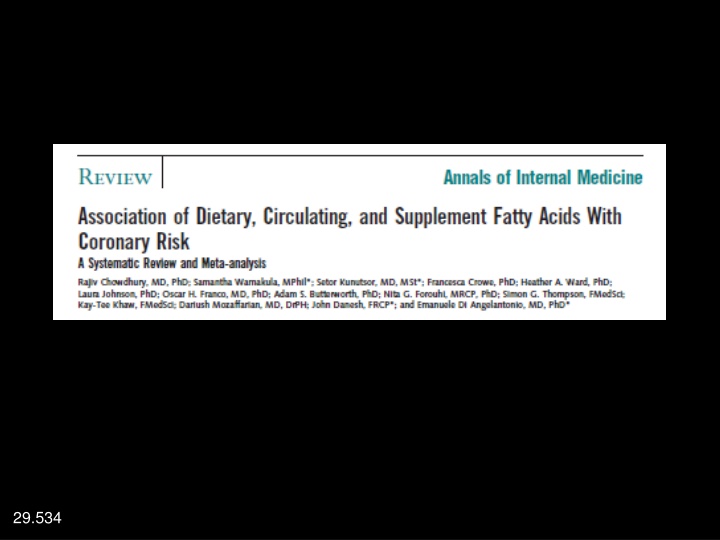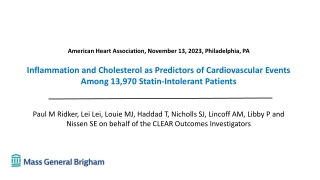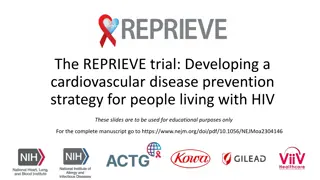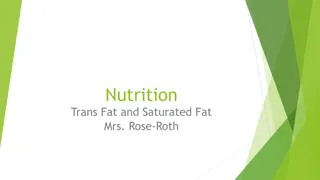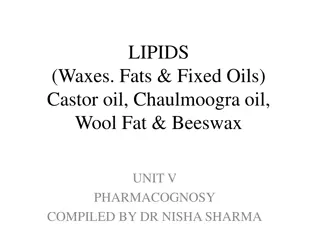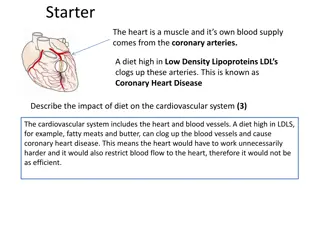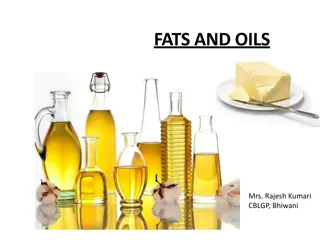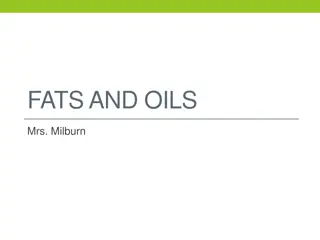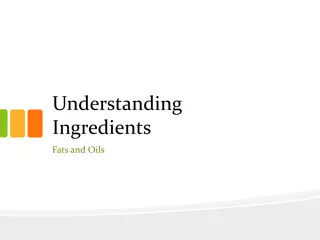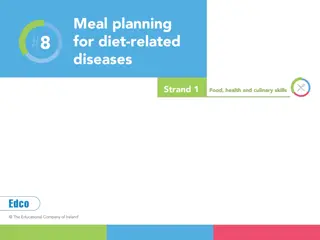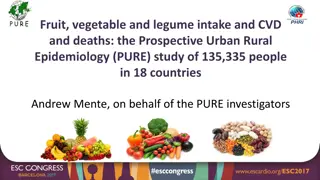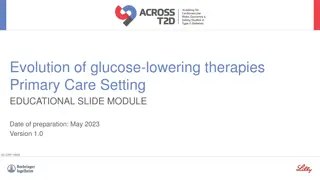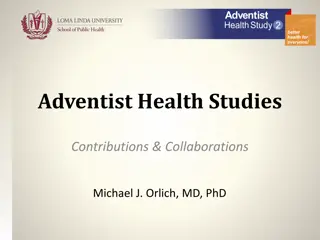Evidence on Dietary Fats and Cardiovascular Health
Conclusions from Chowdhury et al.'s study challenge existing cardiovascular guidelines advocating for high polyunsaturated fatty acid intake and low saturated fat consumption. Strengths of the study include a comprehensive examination of various fats using cohort studies and randomized trials with hard endpoints. However, criticisms include errors in data abstraction, omission of key studies, and misrepresentation of findings. The study types discussed range from ecological studies to randomized trials, each with unique strengths and limitations.
Download Presentation

Please find below an Image/Link to download the presentation.
The content on the website is provided AS IS for your information and personal use only. It may not be sold, licensed, or shared on other websites without obtaining consent from the author.If you encounter any issues during the download, it is possible that the publisher has removed the file from their server.
You are allowed to download the files provided on this website for personal or commercial use, subject to the condition that they are used lawfully. All files are the property of their respective owners.
The content on the website is provided AS IS for your information and personal use only. It may not be sold, licensed, or shared on other websites without obtaining consent from the author.
E N D
Presentation Transcript
Results from Chowdhury et al. (from Abstract) (RRs and 95% CIs for highest vs lowest category) Fat type Cohorts, diet Cohorts, blood Randomized trials Saturated RR = 1.02 ( 0.97-1.07) RR = 1.06 (0.86-1.30) Monounsat RR = 0.99 (0.89-1.09) RR = 1.06 (0.97-1.17) N-6 polyunsat RR = 1.01 (0.96-1.07) RR = 0.94 (0.84-1.06) RR = 0.89 (0.71-1.12) N-3 polyunsat (long chain) Trans RR = 0.93 (0.84-1.02) RR = 1.16 (1.06-1.27) RR = 0.84 (0.63-1.11) RR = 1.05 (0.76-1.44) RR = 0.94 (0.86-1.03) 9.260
Conclusion from Chowdhury Abstract Current evidence does not clearly support cardiovascular guidelines that encourage high consumption of polyunsaturated fatty acids and low consumption of total saturated fats. (Chowdhury R. et al. Ann Intern Med 2014:160:398-406)
http://static01.nyt.com/images/2013/10/04/opinion/contibutors-bittman/contibutors-bittman-thumbLarge-v2.jpghttp://static01.nyt.com/images/2013/10/04/opinion/contibutors-bittman/contibutors-bittman-thumbLarge-v2.jpg Butter is Back March 25, 2014 Mark Bittman Julia Child, goddess of fat, is beaming somewhere. 29.533
Strengths of Chowdhury et al. See comments on Ann Intern Med website: http://annals.org.ezp-prod1.hul.harvard.edu/article.aspx?articleid=1846638 Comprehensive look at multiple fats Inclusion of cohort studies of diet and biomarkers and randomized trials Based on hard endpoints Consistent methods across dietary fats 9.261
Problems with Chowdhury et al. See comments on Ann Intern Med website: http://annals.org.ezp-prod1.hul.harvard.edu/article.aspx?articleid=1846638 Gross errors in data abstraction from original papers Omission of important studies, especially on polyunsaturated fat Omission of important bodies of evidence (e.g. feeding studies) Lack of specific comparisons, and failure to acknowledge this Misrepresentation of findings (especially long-chain N-3 fatty acids) Failure to acknowledge other summaries based on primary data that had different conclusions 9.259
Types of Studies of CHD Study Type Ecological Feeding Studies Strengths Large numbers Control of diet and confounding Clinical outcomes, better control of confounding Control of confounding Limitations Confounding Surrogate outcomes Potential remaining confounding Cohort Studies Randomized Trials Adherence to diet, costly 9.258
10-Year Coronary Incidence Per 10,000 Men Incidence 3000 y=77+78x P=0.73 (Keys 1980) east Finland 2000 west Finland Crevalcore Zutphen 1000 Montegiorgio Belgrade Corfu Zrenjanin Ushibuka Slavonia Velika Krsna Crete Tanushimaru 0 0 5 10 15 20 25 % Diet Calories from Saturated Fat 9.006 Keys, 1980
3000 Y = 10-YEAR CORONARY INCIDENCE PER 10,000 MEN E east Finland Y= 64+27X r = 0.39 2000 W West Finland Italy 1 C N Holland 1000 M Corfu Italy 2 Belgrade, Yugoslavia 3 B R Italy 3 G S Z Yugoslavia 4 D Yugoslavia 2 Japan 1 Slavonia J V Yugoslavia 1 T Japan 2 K Crete 0 10 20 30 40 0 X = % DIET CALORIES FROM TOTAL FATS Ten-year incidence rate of coronary heart disease, by any diagnostic criterion, plotted against the percentage of dietary calories supplied by total fats. (Keys, 1980) 9.005
Keys Serum chol = 1.35 (2 S - P) + 1.5 C0.5 Hegsted Serum chol = 2.16 S 1.65 P + 0.176 C 9.008
Age-adjusted Death Rates for Coronary Heart Disease, US 1950-2007 Deaths 100,000 Population 1,137,000 Deaths Averted in 2007 Due to Decline from Peak Rate in 1968 (1,543,000-406,000) Year Source: NHLBI website, Feb 2012 9.219
Risk of CHD According to P:S Ratio 1.2 Poland 1990 1992 RR of CHD in NHS 1.0 RR for CHD Mortality in 1.0 1994 1996 0.8 1999 0.7 0.6 Poland 0.4 0.2 .33 .56 0.0 0.2 0.3 0.4 0.5 0.6 Dietary P:S Ratio(circles for NHS, squares for Poland) 9.151
Estimated Sources of Calories in US Diet Other carbs Whole grain Potatoes Sat fat Mono fat Refined grain Poly fat Trans fat Protein Added sugar (unpublished, compiled from NHANES) 29.340
Trans Fat Refined Starch, Sugar Saturated Fat Carbohydrates Whole Grains Unsaturated Vegetable Fats --High monounsaturated vegetable fats --High polyunsaturated vegetable fats 29.536
